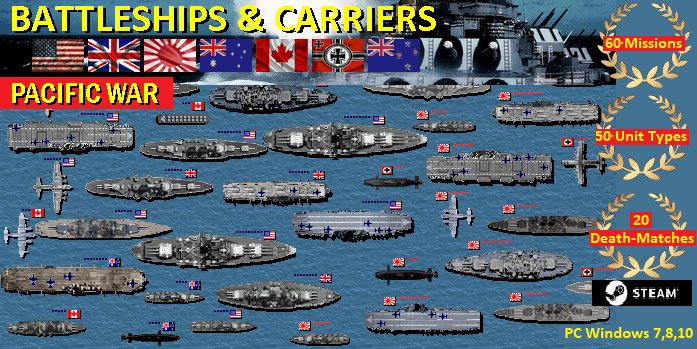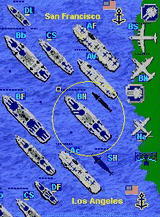Pearl
Harbor Overview
Pearl Harbor Japanese
Forces
Pearl Harbor Japanese
Aircraft
Battle of the Coral
Sea
Doolitle
Raid on Japan
Battle of Midway
Midway_Order_of_Battle
Guadalcanal
Campaign
Guadalcanal-Tulagi
Invasion
Battle of the Philippine
Sea
Battle of Okinawa
Japan
Capitulates
Torch
Operation WW2
WW2 Normandy
Invasion, June 1944
Normandy Crossing
the Channel
The D-Day
Landings, 6 June 1944
www.battle-fleet.com
Battleship Game - WW2 Naval Strategy for PC: the
best choice among aircraft carrier games
and submarine and battleship games.
Soon: also for Android, ipad, iphone
strategy battleship games
Missions and Scenarios:
Pearl Harbor Game
Atlantic Game 1943
Sink Cruisers Game
Midway Game
Iwo Jima Game
US Marines Game
Luftwaffe Game Pacific
Torpedo Game Boats
Bismarck Game Pacific
Destroy RAF Game
Okinawa
US Navy Submarine Game
Fleet Submarines Game
Kamikaze Game
U Boat Game
Singapore Game
Swordfish Hunt
Patrol Boats
Air Supremacy
Alert
Battleships Game
Java
Defense
Fleet Cruisers Game
Atlantic Island
Coral Sea Game
Iron Sea
Mykonos
Imperial Ocean
Long Convoy
Skagerrak
Target Los Angeles
West Pacific Game
Pacific War Game
Leyte Transport
Emperor Hirohito
Normandy Game
South Pacific Game
Destroy USAF Game
Submarine Games
US Navy Game
Free Hunt Doenitz Game
Free Hunt Spruance Game
Free Hunt Halsey Game
Imperial Navy I
Royal Navy Game
Free Hunt Pearl Harbor Games
Midway II
Kriegsmarine I
Brisbane Convoy
Clear West Coast
Fall Of Australia
Battle For Leyte
Conquer Of Japan
HMAS Perth
Road To Okinawa
Orange Ports
Emperor Defense
Prince Of Wales
San Bernardino
Pacific Race
Heavy Duty
Tokio Express
Operation Sidney
Bomber Operation
Conquer Of Italy
Heavy Cruiser Game
Frigate Hunt
Santa Cruz
Lamansh Game
Azores Transport
Norway Convoy
Invasion
Grossadmiral
Norway Ports
Drang Nach Ost
Convoy Pk30
Ciano Defense
Sir John Tovey
Free Hunt Andrews
Germans On Pacific
Silent Hunt
Antigua
Return To Midway
Kriegsmarine Game II
Royal Air Force Game
F. Hunt Lancaster
Jamamoto Game
Free Hunt USN
Free Hunt Japan
Free Hunt RAAF
Free Hunt U Boat Game
Free Hunt Aircraft Carriers Game
Free Hunt Hawaii
Free Hunt Yamato Game
Free Hunt Iwo Jima Game
Free Hunt Pacific Game
Free Hunt Torpedos
Free Hunt Convoy
Free Hunt Germany
Free Hunt Germany II
Free Hunt Italy
Free Hunt Malaya
Free Hunt Subs Game
Free Hunt B-29 Game
Free Hunt USN 1944
Devil Island
Dragoon Carriers Game
|
|
Battle of Iwo Jima - WW2 Battles
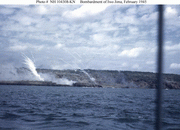 |
|
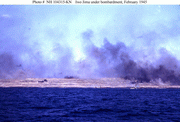 |
|
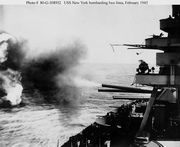 |
|
| Iwo Jima Landing |
|
Battle od Iwo
Jima |
|
Iwo Jima
bombardment |
|
| |
|
|
|
|
|
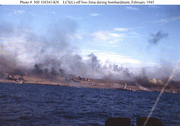 |
|
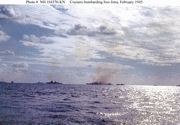 |
|
 |
|
| Iwo Jima Battle |
|
Iwo Jima Task
Force |
|
USS Nevada fires
on Iwo Jima |
|
| |
|
|
|
|
|
On February 19, 1945 about
30,000 United States Marines of the 3rd, 4th and 5th
Marine Divisions, under V Amphibious Corps, landed on Iwo
Jima and a battle for the island commenced. The landing
was called Operation Detachment.
Following the US victory, a group of US Marines reached
the top of Mount Suribachi on February 23, 1945 and
raised the US flag using an old water pipe for a
flagpost. They were persuaded to re-enact the event
shortly afterwards by AP photographer Joe Rosenthal. Of
the six men pictured (Michael Strank, Rene Gagnon, Ira
Hayes, Franklin Sousley, John Bradley, and Harlon Block)
only three (Hayes, Gagnon, and Bradley) survived the
battle. The photo later won a Pulitzer Prize and is the
subject of the USMC War Memorial at Arlington National
Cemetery. Their story is told by Bradley's son James in
Flags of Our Fathers.
The battle ended on March 16, 1945 but small pockets of
Japanese resistance persisted.
"Among the men who
fought on Iwo Jima, uncommon valor was a common
virtue" -- Admiral Chester W. Nimitz
Iwo Jima
Commanders
Commanders
for the operation, code named Detachment, were assigned
as follows:
--Admiral Raymond A. Spruance was the operation's overall
commander.
--Joint Expeditionary Force commander was Vice Admiral
Richmond Kelly Turner. Second in command of the Joint
Expeditionary Force was Rear Admiral Harry W. Hill.
--Lieutenant General Holland M. "Howlin' Mad"
Smith was assigned as the commanding general of the
expeditionary troops.
--The 5th Amphibious Corps was commanded by Major General
Harry Schmidt. Under his command fell the 3rd Marine
Division commander, Major General Graves B. Erskine; the
4th Marine Division commander, Major General Clifton B.
Cates; and the 5th Marine Division commander, Major
General Keller E. Rockey.
| CIA / KGB intelligence game. Run your own operation game.
Travel around the world and set up espionage
game, trade with state secrets, weapon systems,
spy codes, WMD, hire secretaries, agents, lawyers
and soldiers, establish secret agent stations,
cells and bases and search for criminals and
politicians. Involve in agent game. Game contains
more than 40 missions including Nuclear Game,
Cold War Game, Secret Agent, CIA Games, USAF,
Prime Minister, RAF, Bin Laden, Sadam, KGB,
Operations Iran… |
|
Iwo Jima Operation
WW2
Iwo Jima, a member of the Volcano Island group, lies
about a hundred nautical miles southwest of the mid-point
of the direct air route between Saipan, in the Mariana
Islands, and Tokyo. It is about seven-hundred miles from
the Japanese islands of Kyushu and Shikoku, as well as
the southern half of Honshu. Based on Iwo Jima, P-51
fighters and B-24 bombers could conduct useful combat
missions over a large fraction of Japan, while the larger
B-29 bombers could reach targets throughout the country.
Iwo Jima is also the only island in the region with
sufficient flat land for the airfields required to
support a meaningful quantity of such aircraft.
In American hands, Iwo Jima could contribute
significantly to an air campaign against Japan, and make
possible emergency landings by damaged or malfunctioning
bombers. In Japanese posession, it facilitated fighter
interception of B-29s en route from the Marianas to
Japan, thus forcing the bombers to fly a longer route for
their own safety. In addition, it supported counter-raids
on the Americans' Marianas airfields. General Henry H.
Arnold, the U.S. Army Air Forces' commander, was an early
advocate of capturing Iwo Jima and, by the beginning of
October 1944, the island was targeted for invasion early
in the following year.
This useful, geologically active (its name means
"Sulfur Island" in Japanese) speck of land is
just under five nautical miles long, measured along a
north-northeasterly axis, and about two-and-a-half
nautical miles broad in its northern part, with a total
area of some eight square miles. Its most prominent
terrain feature is the volcanic cone of Mount Suribachi
(labeled "Hot Rocks" in the Iwo Jima operation
plan), rising some 550 feet above the sea at the southern
end. At Suribachi's base, Iwo Jima is about 800 yards
across, and is relatively flat and smooth for a few miles
to the northward. Weather permitting, the beaches on both
shores in this vicinity can be used by beaching craft and
amphibious vehicles, though the shoreline and inland area
is covered with loose volcanic ash -- too soft and
yielding for convenient human and vehicular traffic. The
island's northern area is rocky and rugged, with a
shoreline unsuitable for landings and an interior of
hills, ravines and other broken ground. Iwo Jima's
surface rock, both in the north and at Mount Suribachi,
is soft enough to facilitate tunneling.
By late 1944, the Japanese had completed two airfields
and had begun a third. They were vigorously fortifying
the island, preparing an interlocking network of tunnels,
trenches and deep caverns. Covered gun positions were
carved into Suribachi's slopes and the northern area and,
where the native rock was inadequate for such works,
reinforced concrete blockhouses were erected. Artillery,
mortars and machine guns dominated all potential landing
beaches. More than twenty-thousand troops manned these
formidable defenses. With good reason, Japanese Army
Lieutenant General Tadamichi Kuribayshi, Iwo Jima's
commander, considered that his well-protected and
highly-motivated men could defeat an invasion attempt by
superior ground forces, even when the latter were
supported by seemingly overwhelming air and sea power.
In the opening days of 1945, Japan faced the prospect of
invasion by the Allied Forces. Daily bomber raids from
the Marianas hit the mainland in an operation called
Scavenger. Fighters and Kamikaze at Iwo Jima provided a
measure of defense. Eventually the Allies would have to
take Iwo Jima, part of the Japanese homeland for over 600
years. The Japanese were ready. The island was garrisoned
by 22,000 soldiers and fortified in a network of
underground bunkers.
The defense of Iwo Jima
was to exact such a price on Allied Forces as to
discourage invasion of the mainland. Each defender was
expected to die in defense of the homeland, taking 10
enemy soldiers in the process.
The Allies, led by the
United States of America, wanted Iwo Jima not only to
neutralize threats to its bombers and shipping, but to
use its airfields for fighter escort and emergency bomber
landings. On February 16, 1945, they commenced a
three-day air and gun assault on the island with
unprecedented ferocity, but little effect on the
sheltered garrison of Japanese troops.
Invasion of Iwo Jima
At 2 AM on the morning of
February 19, battleship guns signaled the commencement of
D-Day. Soon 100 bombers attacked the island, followed by
another volley from the naval guns. At 8:30, Marines
disembarked toward the shores of Iwo Jima. Their
objective -- Suribachi Mountain, at the south of the
island, which guarded the beaches.
The Marines faced heavy
fire from Suribachi and inhospitable terrain, rough
volcanic ash which allowed neither secure footing or the
digging of a foxhole. They were sitting ducks. Still, by
that evening, the mountain had been surrounded and 30,000
Marines had landed. About 40,000 more would follow.
The climb up Suribachi was
fought by the yard. Gunfire was ineffective against the
Japanese, but flame throwers and grenades cleared the
bunkers. Finally, on February 23, the summit had been
reached. The erection of the US flag that day proved an
inspiration not only to the combatants but to a grateful
nation for years to come.
The Battle
of Iwo Jima Continues
Feb. 20, one day after the
landing, the 28th Marines secured the southern end of Iwo
and moved to take the summit of Suribachi. By day's end,
one third of the island and Motoyama Airfield No. 1 was
controlled by the Marines. By Feb. 23, the 28th Marines
would reach the top of Mount Suribachi and raise the U.S.
flag.
The 3rd Marine Division
joined the fighting on the fifth day of the battle. These
Marines immediately began the mission of securing the
center sector of the island. Each division fought hard to
gain ground against a determined Japanese defender. The
Japanese leaders knew with the fall of Suribachi and the
capture of the airfields that the Marine advance on the
island could not be stopped; however, they would make the
Marines fight for every inch of land they won.
Lieutenant General Tadamishi Kuribayashi, commander of
the ground forces on Iwo Jima, concentrated his energies
and his forces in the central and northern sections of
the island. Miles of interlocking caves, concrete
blockhouses and pillboxes proved to be one of the most
impenetrable defenses encountered by the Marines in the
Pacific.
The Marines worked together to drive the enemy from the
high ground. Their goal was to capture the area that
appropriately became known as the "Meat
Grinder." This section of the island included three
distinct terrain features, which were the highest point
on the northern portion of the island, Hill 382; an
elevation known as "Turkey Knob," which had
been reinforced with concrete and was home to a large
enemy communications center, and the
"Amphitheater," a southeastern extension of
Hill 382.
The 3rd Marine Division encountered the most heavily
fortified portion of the island in their move to take
Airfield No. 2. As with most of the fighting on Iwo Jima,
frontal assault was the method used to gain each inch of
ground. By nightfall on March 9, the 3rd division reached
the island's northeastern beach, cutting the enemy
defenses in two.
On the left of the 3rd Marine Division, the 5th Marine
Division pushed up the western coast of Iwo Jima from the
central airfield to the island's northern tip. Moving to
seize and hold the eastern portion of the island, the 4th
Marine Division encountered a "mini banzai"
attack from the final members of the Japanese Navy
serving on Iwo. This attack resulted in the death of
nearly 700 enemy and ended the centralized resistance of
enemy forces in the 4th division's sector. The 4th
division would join forces with the 3rd and 5th on the
coast on March 10.
A proud moment for those who worked so hard to gain
control of the island was when the first emergency
landing was made by a B-29 bomber on March 4. Repairs
were made, refueling was completed and the aircraft was
off to complete its mission.
Operations entered the final phases March 11; enemy
resistance was no longer centralized. Individual pockets
of resistance were taken one by one.
Finally on March 26, following a banzai attack against
troops and air corps personnel near the beaches, the
island was declared secure. The U.S. Army's 147th
Infantry regiment assumed ground control of the island on
April 4, relieving the largest body of Marines committed
in combat
Northern Iwo
Jima
Despite
the loss of Mount Suribachi on the south end of the
island, the Japanese still held strong positions on the
north end. The rocky terrain vastly favored defense, even
more so than Mount Suribachi. Coupled with this, the
fortifications constructed by Kuribayashi were more
impressive than at the Southern end of the island.
Remaining under the command of Kuribayashi was the
equivalent of eight infantry battalions, a tank regiment,
two artillery, and three heavy mortar battalions. Also he
had about 5,000 gunners and naval infantry. The most
arduous task left to the Marines was the overtaking of
the Motoyama Plateau with its distinctive hill 382 and
Turkey knob and the area in between referred to as the
Amphitheater. This formed the basis of what came to be
known as the "meatgrinder". While this was
being achieved on the right flank, the left was clearing
out hill 362 with just as much difficulty. The overall
objective at this point was to take control of airfield
no. 2 in the center of the island. However, every
"penetration seemed to become a disaster" as
"units were raked from the flanks, chewed up –
sometimes wiped out. Tanks were destroyed by interlocking
fire or were hoisted into the air on the spouting
fireballs of buried mines". As a result the fighting
bogged down with Americans casualties piling up. Even
capturing these points was not a solution to the problem
since a previously secured position could be attacked
from the rear by the use of the tunnels and hidden
pillboxes. As such, it was said that "they could
take these heights at will, and then regret it".
The Marines nevertheless found ways to prevail under the
circumstances. It was observed that during bombardments,
the Japanese would hide their guns and themselves in the
caves only to reappear when the troops would advance and
lay devastating fire on them. Consequently, General
Erskine ordered the Ninth Marines to attack under the
cover of darkness with no preliminary barrage. This came
to be a resounding success with many soldiers taken out
while still sleeping. This was a key moment in the
capture of hill 362. It held such importance that the
Japanese organized a counterattack the following night.
Although Kuribayashi had forbidden the suicide charges
familiar with other battles in the Pacific, the commander
of the area decided on a banzai charge with the
optimistic goal of recapturing mount Suribachi. Captain
Samaji Inouye and his 1000 men charged the American
position inflicting 347 casualties (90 deaths). The
Marines counted 784 dead Japanese soldiers the next day.
There was also a Kamikaze air attack (the only one of the
battle) on the ships anchored at sea on February 21 which
resulted in the sinking of the escort carrier Bismark
Sea, severe damage to Saratoga and slight damage to the
escort carrier Lunga Point, an LST and a transport.
Although the island was officially declared secure at 6pm
on March 16, 25 days after the landings, the 5th Marine
Division still faced Kuribayashi's stronghold in a gorge
700 yards (640 m) at the north-western end of the island.
On March 21, the Marines destroyed the command post in
the gorge with four tons of explosives and on March 24,
Marines sealed the remaining caves at the northern tip of
the island. However, on the night of March 25, a 300-man
Japanese force launched a final counterattack in the
vicinity of Airfield Number 2. Army pilots, Seabees and
Marines of the 5th Pioneer Battalion and 28th Marines
fought the Japanese force for up to 90 minutes but
suffered heavy casualties (53 were killed, and another
120 were wounded).[citation needed] Two Marines from the
36th Depot Company, an all-African-American unit,
received the Bronze Star. 1st Lieutenant Harry Martin of
the 5th Pioneer Battalion was the last Marine to be
awarded the Medal of Honor during the battle.
Although still a matter of speculation because of
conflicting accounts from surviving Japanese veterans, it
has been said that Kuribayashi led this final assault,[2]
which unlike the loud banzai charge of previous battles,
was characterised as a silent attack. If ever proven
true, Kuribayashi would have been the highest ranking
Japanese officer to have personally led an attack during
World War II. Additionally, this would also be
Kuribayashi's final act of departure from the normal
practice of the commanding Japanese officers committing
seppuku behind the lines while the rest perished in the
banzai charge, as happened during the battles of Saipan
and Okinawa.
Securing the Iwo Jima
With the landing area
secure, more Marines and heavy equipment were landed and
the invasion proceeded north to capture the airfields and
the remainder of the island. Iwo Jima was declared secure
on March 26. As commanded, the Japanese defended the
homeland to the death. Of over 20,000 defenders, only
1,000 were taken prisoner
Iwo Jima Campaign
results
The 36-day assault
resulted in more than 26,000 American casualties,
including 6,800 dead. Of the 20,000 Japanese defenders,
only 1,083 survived. The Marines' efforts, however,
provided a vital link in the U.S. chain of bomber bases.
By war's end, 2,400 B-29 bombers carrying 27,000 crewmen
made unscheduled landings on the island.
Historians described U.S.
forces' attack against the Japanese defense as
"throwing human flesh against reinforced
concrete." In the end, Iwo Jima was won not only by
the fighting spirit of the Marines, but by the meticulous
planning and support provided by the Navy and Army
through supply efforts, medical care, and air and naval
gunfire.
Twenty-seven Medals of
Honor were awarded to Marines and sailors, many
posthumously, more than were awarded for any other single
operation during the war.
Iwo Jima
- Two flag raisings
At 8 a.m., on Feb. 23, a
patrol of 40 men from 3rd Platoon, E Company, 2nd
Battalion, 28th Marines, led by 1st Lieutenant Harold G.
Schrier, assembled at the base of Mount Suribachi. The
platoon's mission was to take the crater at Suribachi's
peak and raise the U.S. flag.
The platoon slowly climbed the steep trails to the
summit, but encountered no enemy fire. As they reached
the top, the patrol members took positions around the
crater watching for pockets of enemy resistance as other
members of the patrol looked for something on which to
raise the flag.
At 10:20 a.m., the flag was hoisted on a steel pipe above
the island. This symbol of victory sent a wave of
strength to the battle-weary fighting men below, and
struck a further mental blow against the island's
defenders.
Marine Corps photographer Sergeant Lou Lowery captured
this first flag raising on film just as the enemy hurled
a grenade in his direction. Dodging the grenade, Lowery
hurled his body over the edge of the crater and tumbled
50 feet. His camera lens was shattered, but he and his
film were safe.
Three hours later another
patrol was dispatched to raise another, larger flag. The
battle for Iwo Jima is encapsulated by this historic flag
raising atop Suribachi, which was captured on film by
Associated Press photographer Joe Rosenthal. His photo,
seen around the world as a symbol of American values,
would earn him many awards including the 1945 Pulitzer
Prize.
Over the years, the flag raising has come to symbolize
the spirit of the Corps to all Marines. On Nov. 19, 1954,
a bronze monument of the flag raising, sculpted by Felix
de Weldon and located near Arlington National Cemetery,
was dedicated to all Marines who have given their lives
in defense of their country.
Then Vice President Richard M. Nixon said, "This
statue symbolizes the hopes and dreams of America, and
the real purpose of our foreign policy. We realize that
to retain freedom for ourselves, we must be concerned
when people in other parts of the world may lose theirs.
There is no greater challenge to statesmanship than to
find a way that such sacrifices as this statue represents
are not necessary in the future, and to build the kind of
world in which people can be free, in which nations can
be independent, and in which people can live together in
peace and friendship."
Text is available under
the terms of the GNU Free Documentation License
|
After the American seizure of the
Marshall Islands and devastating air attacks against Truk
in the Caroline Islands in February 1944 the Japanese
military leadership reappraised the military situation.
All indications pointed to an American drive towards the
Marianas and Carolines. To counter such a move they
established an inner line of defense extending generally
northward from the Carolines to the Marianas, and thence
to the Ogasawara Islands. In March 1944 the Thirty-First
Army, commanded by General Hideyoshi Obata, was activated
for the purpose of garrisoning this inner line.
| |
| |
|
| Tycoon Strategy
Game - build your own world business empire as an
arms dealer tycoon. Travel around the world,
trade with more than 400 weapon systems, hire
secretaries, bodyguards, lawyers, fighters and
tanks, establish companies and search for
criminals and hostages. |
Following
the American seizure of bases in the Marshalls in the
battles of Kwajalein and Eniwetok in February 1944 both
Army and Navy reinforcements were sent to Iwo Jima. Five
hundred men from the naval base at Yokosuka and an
additional 500 from Chichi Jima reached Iwo Jima during
March and April 1944. At the same time, with the arrival
of reinforcements from Chichi Jima and the home islands,
the Army garrison on Iwo Jima had reached a strength of
over 5,000 men, equipped with 13 artillery pieces, 200
light and heavy machine guns, and 4,552 rifles. In
addition there were numerous 120 mm coastal artillery
guns, twelve heavy anti-aircraft guns, and thirty 25 mm
dual-mount anti-aircraft guns.
| |
|
|
| |
|
|
| |
|
|
| |
Turn-based
trade strategy game. Build your
own world empire as an arms dealer.
Trade with weapons, hire spies, agents,
secretaries, bodyguards and lawyers, and
establish bases and spy cells worldwide.
Trading cards game combat system included.
|
|
The loss of the Marianas during the northern summer of
1944 greatly increased the importance of the Ogasawaras
for the Japanese, who were well aware that the loss of
these islands would facilitate American air raids against
the home islands, disrupting war manufacturing and
severely damaging civilian morale.[2]
| |
 PC PC |
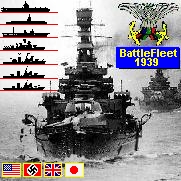 |
Turn-based WW2
naval game, extension to the classic
Submarine game (Battleship game) where
ships/planes/subs can move. Contains plenty of
game missions, game campaigns and 40 ship,
submarine, airplane ana port artillery types,
with combat maps up to 96X96 large.
Soon: also for Android, ipad, iphone
strategy battleship games |
| |
| |
|
Guns Girls
Lawyers Spies is a trade management game.
You'll build your multinational spy company,
destroy competition, hire employees, spies, and
businessman, establish spy cells, bases and
objects.
There is a more than 40 missions with different
game objectives. |
| |
Final Japanese plans for the defense of the Ogasawaras
were overshadowed by the fact that the Imperial Japanese
Navy had already lost most of its strength and could no
longer prevent American landings. Moreover, aircraft
losses throughout 1944 had been so heavy that, even if
war production were not affected by American air attacks,
combined Japanese air strength was not expected to
increase to 3,000 aircraft until March or April 1945.
Even then, these planes could not be used from bases in
the home islands against Iwo Jima because their range did
not exceed 900 km (559 miles); besides, all available
aircraft had to be hoarded for possible use on Taiwan and
adjacent islands near land bases.
Iwo Jima -
Strategic importance
Given the number of
casualties, the necessity and long-term significance of
the island's capture to the outcome of the war was a
contentious issue from the beginning, and remains
disputed. As early as April 1945 retired Chief of Naval
Operations, William V. Pratt, asked in Newsweek magazine
about the
“ expenditure of manpower to acquire a small,
God-forsaken island, useless to the Army as a staging
base and useless to the Navy as a fleet base ... [one]
wonders if the same sort of airbase could not have been
reached by acquiring other strategic localities at lower
cost. ”
Dinah Might surrounded by Marines and Seabees after
emergency landing on Iwo Jima
The Japanese on Iwo Jima had
radar and were thus able to notify their comrades at home
of incoming B-29 Superfortresses flying from the Mariana
Islands. Fighter aircraft based on Iwo Jima sometimes
attacked these planes, which were especially vulnerable
on their way to Japan because they were heavily laden
with bombs and fuel. Although the island was used as an
air-sea rescue base after its seizure, the traditional
justification for Iwo Jima's strategic importance to the
United States' war effort has been that it provided a
landing and refueling site for American bombers on
missions to and from Japan. As early as March 4, 1945,
while fighting was still taking place, the B-29 bomber
Dinah Might of the USAAF 9th Bomb Group reported it was
low on fuel near the island and requested an emergency
landing. Despite enemy fire, the airplane landed on the
Allied-controlled section of the island, without
incident, and was serviced, refueled and departed. In
all, 2,251 B-29 Superfortress landings on Iwo Jima were
recorded during the war. Moskin records that 1,191
fighter escorts and 3,081 strike sorties were flown from
Iwo Jima against Japan.
None of these calculations
played much if any of a role in the original decision to
invade, however, which was almost entirely based on the
Army Air Force's belief that the island would be a useful
base for long-range fighter escorts. These escorts proved
both impractical and unnecessary, and only ten such
missions were ever flown from Iwo Jima. Other
justifications are also debatable. Although some Japanese
interceptors were based on Iwo Jima, their impact on the
American bombing effort was marginal; in the three months
before the invasion only 11 B-29s were lost as a result.
The Superfortresses found it unnecessary to make any
major detour around the island. The capture of Iwo Jima
did not affect the Japanese early-warning radar system,
which continued to receive information on incoming B-29s
from the island of Rota (which was never attacked).
Some downed B-29 crewmen were saved by air-sea rescue
aircraft and vessels operating from the island, but Iwo
Jima was only one of many islands that could have been
used for such a purpose. As for the importance of the
island as a landing and refueling site for bombers,
Marine Captain Robert Burrell, then a history instructor
at the United States Naval Academy, suggested that only a
small proportion of the 2,251 landings were for genuine
emergencies, the great majority possibly being for minor
technical checkups, training, or refueling. According to
Burrell,
“ this justification became prominent only after the
Marines seized the island and incurred high casualties.
The tragic cost of Operation Iwo Jima pressured veterans,
journalists, and commanders to fixate on the most visible
rationalization for the battle. The sight of the
enormous, costly, and technologically sophisticated B-29
landing on the island's small airfield most clearly
linked Iwo Jima to the strategic bombing campaign. As the
myths about the flag raisings on Mount Suribachi reached
legendary proportions, so did the emergency landing
theory in order to justify the need to raise that flag.
”
Nevertheless, in promoting his expanded exploration of
the issue, The Ghosts of Iwo Jima, Burrell's publishers
also claim that the very losses formed the basis for a
"reverence for the Marine Corps" that not only
embodied the "American national spirit" but
ensured the "institutional survival" of the
Marine Corps.
|
